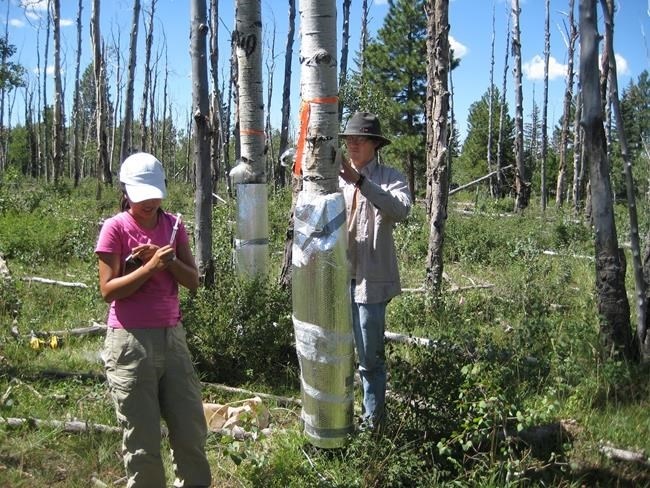
Researchers study stressed forests in the southwestern United States in this undated handout photo. New research suggests that Canada's drought-stricken forests will take years longer to recover from dry weather than previously thought. In a study published in Science magazine, William Anderegg of Princeton University said trees feel the lingering effects of a drought for up to four years.
Image Credit: THE CANADIAN PRESS/HO - Princeton University, William Anderegg
July 30, 2015 - 12:58 PM
New research suggests that Canada's drought-stricken forests will take years longer to recover from dry weather than previously thought.
In a study published in Science magazine, William Anderegg of Princeton University said trees feel the lingering effects of a drought for up to four years.
"Drought is always (thought of) as a light switch: when it's dry, trees grow slowly, but the moment the rains come back and the soil gets wetter, it's like the trees recover perfectly and almost immediately," he said.
"It turns out it doesn't work like that."
The findings are expected to affect everyone from foresters estimating harvest rates to climate modellers trying to understand how forests affect greenhouse gas emissions, especially as Canada's great northern greenbelt continues to warm.
Anderegg's findings are based on an analysis of tree rings from more than 1,300 trees around the world.
He and his colleagues compared growth rates in the years following droughts with the average growth rate for a tree in those locations.
The differences were substantial.
Researchers concluded that trees grew an average of nine per cent less the first year after a drought and about five per cent less the second year. For some types of trees, effects continued for another two years.
The researchers used 18 different methods of measuring drought and each gave a similar result.
"It seems like trees are pretty sensitive to drought and they just take a while to recover."
The effects were most noticeable in pines and aspens — two of the most common species in the vast swath of boreal forest that stretches across Canada.
"A lot of people are concerned," said Anderegg. "They've started to see some pretty big drought effects in Canada's boreal forest.
"There's been documented increasing tree mortality rates. (And) our study adds to these concerns."
Agriculture Canada figures suggest the Northwest Territories and the northern reaches of the provinces have received between 60 and 85 per cent of normal precipitation this summer. But after repeated dry years, soil moisture is less than 40 per cent of normal.
Anderegg noted his study didn't look into what happens after multiple drought years.
The study could lead to changes in forest management, Anderegg suggested. Because wildfires are routinely suppressed, many forests are denser than they would naturally be.
"That leaves them vulnerable to drought, large forest fires and insect outbreaks. Things like thinning out the density of trees would certainly increase resilience."
The findings could also mean climate modellers have been significantly overestimating the amount of greenhouse gases that forests absorb from the atmosphere, now thought to equal about one-quarter of all human emissions.
"Because climate change is projected to have more intense and more frequent droughts, forests are going to spend more of their time recovering than we thought and they're growing to be growing more slowly and taking out less carbon."
News from © The Canadian Press, 2015